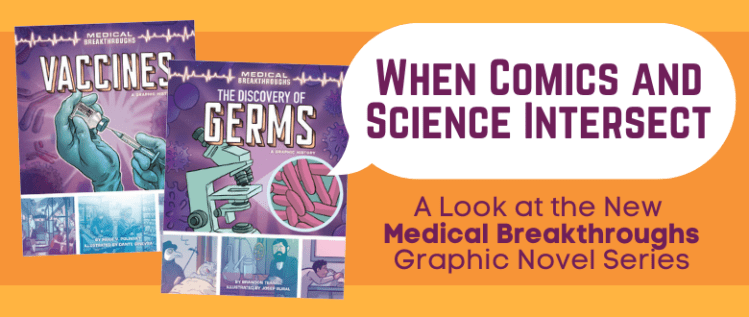When Comics and Science Intersect

In the following post, designer Mary Ross shares her experience working on the Medical Breakthroughs graphic novel series and explores why the graphic novel medium offers a unique way to teach history and science!
Like many designers, I am and always have been a very visual person, naturally drawn to the medium of a graphic novels to explain complex ideas. I was also raised in a household with a parent working in the medical field. Growing up, these two worlds intersected and entwined themselves into a combination that influenced how I design today; clean and precise, with all the right information shown in an easy-to-understand way, as best I can. While these two worlds are not normally mutually exclusive, I was giddy at the thought of combining a subject as austere as the medical field with the format of something as visual and engaging as a graphic novel.
The main concern in building the Medical Breakthroughs series was accurately approaching the various medical topics in factual, scientific, and historical manners while also being easily digestible to the young reader. While some topics addressed in the books can be relatively scary to learn about (the first heart transplant, diseases such as the plague, premature babies in incubators, etc.) the format of the graphic novels makes them less daunting to understand by substituting a child’s wild imagination with accurate, well-informed illustrations.

Another unique quality to this series is that we worked with two different illustrators to do art for the books. Three titles were illustrated by Josep Rural and three others were done by Dante Ginevra. What I love about having two different artists is that their illustration styles couldn’t be more different, with Dante’s style being darker and more comic book-esque, and Josep’s style being much lighter and simpler, akin to picture book illustrations. The alternating styles help break up the overall tone of the series by being equal parts intense, clinical, clean, and easy to understand.
Another interesting part of putting this series together was keeping in mind how important this information is to give to readers today with the COVID-19 pandemic crisis continuing all over the world. Questions that arose include “Do we add masks to the scenes of kids in school? Do we put them on people riding in public transportation? How relevant will that continue to be moving forward?” My hope is that their presence relays an honest look at the public health realities that these books are informing readers of, and that these books offer factual and informative accounts of medical breakthroughs to the younger minds of today.
Medical Breakthroughs
6 Book Series
Interest Level: Grade 3 – Grade 6 | Reading Level: Grade 4
Explore major medical events and the scientific breakthroughs that made them possible. With an accessible graphic nonfiction approach, each title in the Medical Breakthroughs series spotlights the famous figures behind notable discoveries. A lively tone and dynamic visuals guide readers through different historical eras and present STEM concepts in a fun, inviting fashion. Readers won’t want to put down these high-interest true stories, as they learn more about the innovations that help save lives.

Comments
Graphic Novels are a wonderful way to introduce kids to science! Medical Breakthroughs rock!